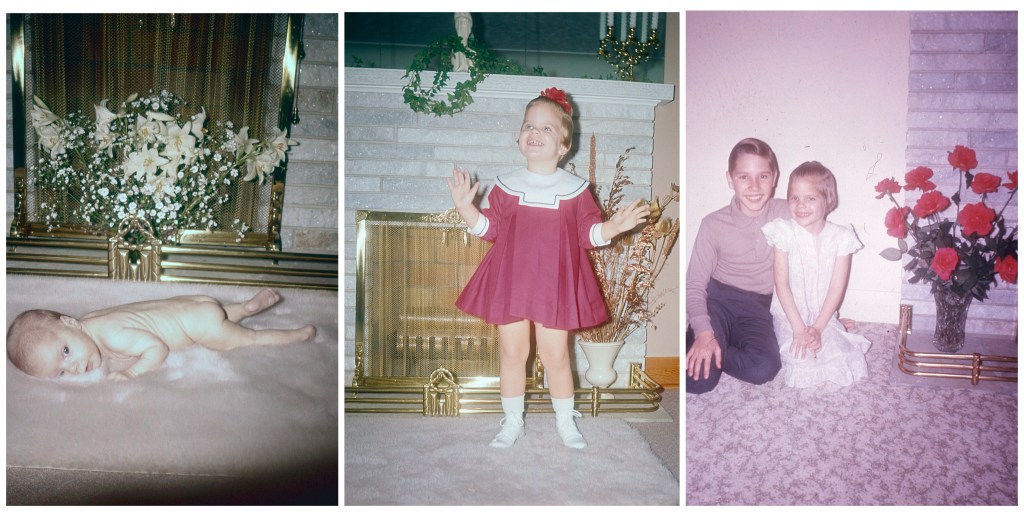When I was girl, our family home had a wood-burning fireplace in the combined living room and dining room but I never remember seeing a fire in it. The surround featured some kind of sparkly white brick or stone, with white birch logs stacked neatly on the grate, and my guess is that allowing any kind if soot near all that pristine surface was not in my mother’s game plan. It was the go-to backdrop for family photos, though:

The house of my teenage years, a 1970s’ suburban two storey, did have a wood-burning fireplace in the main-floor family room but eventually my father replaced it with a gas insert: they were more likely to turn on the fireplace while watching TV in the winter if it didn’t involved stacking logs and cleaning out ash the next morning.
In my early career years, I lived for a few months in one apartment built in the 1920s and it had a charming little electric fireplace where a fan moved around a disc that created flame-like flickers. My second house I owned had a real fireplace — one where you could burn wood — although it was shallow and did better with the pre-fab three-hour fireplace logs where the paper wrapper serves as the kindling material.
On the “must have” list when we were house-hunting in 2019 was a fireplace, the ultimate cozy comfort on a dark and cold winter’s night. The place we bought didn’t have one, so that item moved to the “nice to have” / “oh well, maybe next time” column in the eternal house evaluation grid.
When we originally set out a redesign of our main floor, and the living room was set to be in what we now call the “problem child room”, we thought maybe we could find a way to fit in a fireplace there. We started looking at electric options so we could consider putting a fireplace on any wall, and the ones we saw in showrooms had zero charm, compared with that little old model from my 1920s’ apartment, all those many years ago.
Was there way to make a gas fireplace, which looked much more, well, fireplace-y, work? Kevin Adams from TriCounty Brick in Stratford, a go-to shop for fireplaces here, did a site visit and suggested building a 45-degree angled wall in one corner of the room. The fireplace could vent out the wall into our courtyard and all would be well with the world.
One annoying trait of gas fireplaces — at least for those of us who want them to mimic wood-burning fireplaces as much as possible — is that they’ve been built to be efficient heat sources. That means they have temperature sensors and, when the room has heated to a certain point, the fireplace shuts off. Now, I want that quality in a furnace. But I want to see flames all evening when the wind is howling and the fire is what reminds you there are better days ahead. Naively, I asked: is there a way to keep the gas fireplace flames running without throwing heat? (The answer is no.)
Our solution was to buy a less-powerful unit that won’t throw as much heat but might have a chance of staying on for longer than five minutes at a time.
When we did more rearranging of room uses, Kevin returned to see if we could put the fireplace, which we’d already ordered, in the new living room location. The answer, thankfully, was yes.
It’s now installed and we’ll see, once everything else is moved back in, if we’ll leave the surround as simple as it is now or if it needs a bit more dressing up. I’ll also be on the hunt in the spring for a tall-growing shade-loving shrub that eventually will camouflage the fireplace’s mechanical exhaust box now protruding from the house’s north wall.
A gas fireplace will never replace the full sensory experience of a wood-burning fire, with its smoky smell and crackling sounds. But I will still breathe a happy exhale, curled up on the nearby couch with a book in hand, once we can put our feet up by the fire after we’ve stopped travelling down Renovation Road.
One Comment Add yours